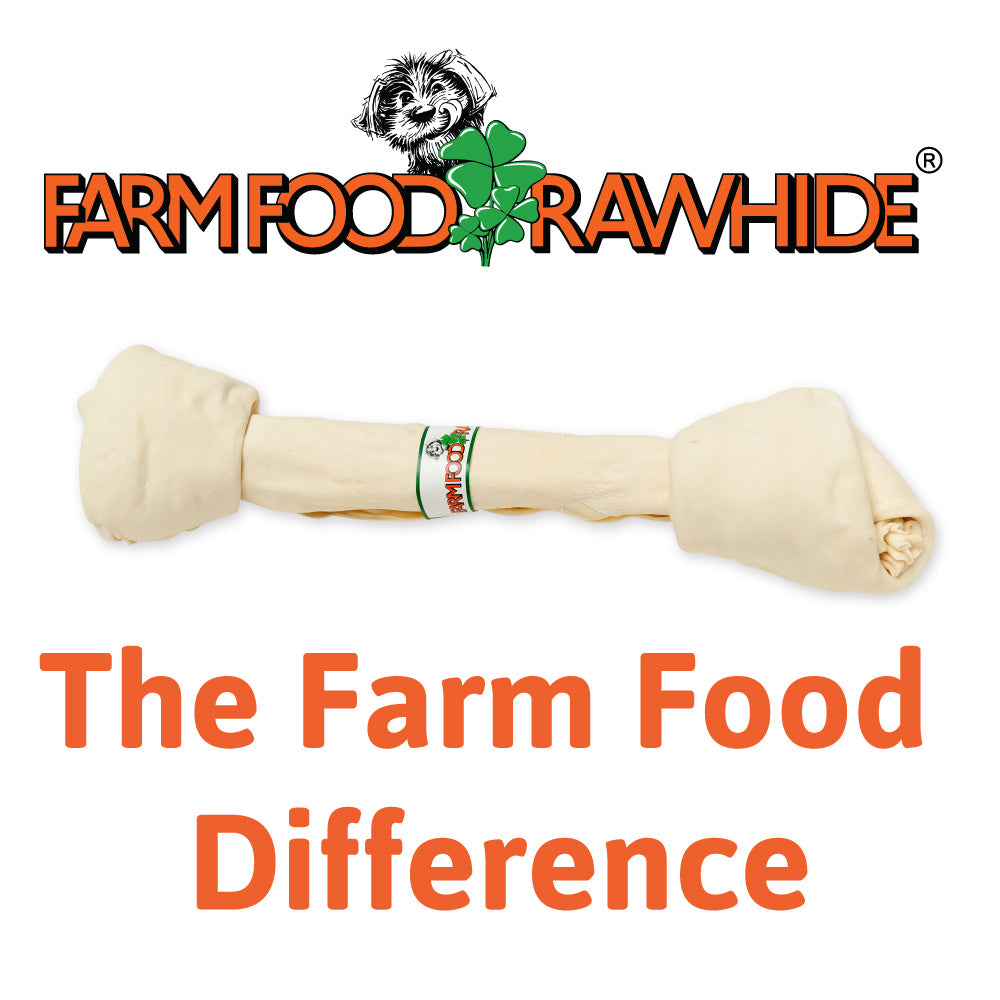
Rawhide - The Farm Food Difference
Share


When you say the word Rawhide to most people, they will think about one of two things – The popular 1960’s TV show starring Clint Eastwood or the dog chew.
Sadly for fans of western films, we are going to discuss the dog chew in this blog.
For years, reports have been circulating around social media and websites about the harmful production methods used to make dog chews, lumping all dog chews together under the rawhide moniker. Although we consider much of this to be scaremongering and ‘Fake News’, we certainly understand the customer concerns have over rawhide, which is why we’d like to pass on information about the quality of Farm Food Rawhide.
As in all areas of pet food, you get the good, the bad, and the ugly, and before you, the consumer, hands over a fistful of dollars, you want to make sure you’re getting the best for your pet.
No leather here!
There are many different dog chews available, varying in quality, which are made from hide (commonly referred to as rawhide). Many are made from tanned hide (also known as leather hide). Since 1996, Farm Food has only sold dog chews made from subcutaneous tissue. We do not use any leather hide in the production of our dog chews.
We know that, in some countries, a range of different chemicals is used to preserve the hides before they are made into dog chews. This kind of preservation is necessary because the hides often spend quite a long time in transit before they reach the production facility. These countries are mostly in the Far East. Several chemicals are also used to remove the hair from the hides.
Farm Food does not use any of these chemicals (which, in most cases, are metal salts). We are well aware of the negative effects they can have on dogs' health. The subcutaneous tissue is delivered fresh to our production facility, which renders the use of such chemicals obsolete.
In addition, the subcutaneous tissue has already been removed from the leather hide when it reaches us, so the subcutaneous tissue never comes into contact with the kinds of chemicals used to remove hair from the hides.
Because we are extra vigilant about this, we regularly test our products for the metals that are generally found in metal salts used for preservation. This includes Arsenic, Lead, Cadmium and Mercury. Any product found to include these would be destroyed and the batch fully tested. Thankfully this is an incredibly rare occurrence.
Subcutaneous Tissue
What is subcutaneous tissue? Simply put it is the second, strong and tough layer of the skin of cattle. Ours come from free-range cattle which have been imported from Europe. The outer, indigestible layer is removed for leather production in the process. The inner layers, digestible, subcutaneous connective tissue are washed and cut into pieces to the desired size. After being manually folded in the various shapes, the white chew bones are dried in an oven for several days. One very important aspect of our products is that, because of quick processing, no harmful substances are used during the entire production process. This allows us to guarantee a clean, pure and safe product.

The same subcutaneous tissue that we use for our dog chews is made up of collagen and is also used in the food service industry to make gelatine. Gelatine has a wide range of applications, including in soft drinks, sweets (wine gums), soups and puddings, but it is also commonly used in the shell capsules around medicines. The latter, in our view, paints a good picture of the quality of the rawhide we work with. If there's one sector that regulates its ingredients well, it’s the pharmaceutical industry!
Sticky Business
There have also been reports that glue is used in the production of rawhide. We never use glue in our production process. Of course, we can't speak for other rawhide products. Subcutaneous tissue is self-adhesive, thanks to the drying process and the fact that it's made of collagen, so it retains its form once it's dried. Glue is simply not necessary.
A lot of dog chews come from Asia (primarily China, Thailand and India). The quality of dog chews produced in these countries often leaves much to be desired and the production process is difficult to monitor. That's why we stay clear of dog chews made in those countries.
You are certainly aware that quality can vary tremendously when it comes to dog chews that are available on the market today. Unfortunately, all knotted dog chews are often lumped in together as “Rawhide”, which we don't think is right.
We hope this explanation has allayed your concerns somewhat and acted as a counterbalance to the 'scaremongering' that's out there on the internet.
As you can see, it is worth spending a few dollars more on a high quality, natural rawhide dog chew than a cheap alternative. Should you have any questions, please do get in touch as we would be glad to help!
